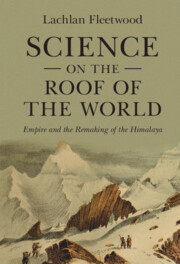Book contents
- Science on the Roof of the World
- Science in History
- Science on the Roof of the World
- Copyright page
- Dedication
- Contents
- Figures
- Acknowledgements
- Maps
- Introduction
- 1 Measuring Mountains
- 2 Unstable Instruments
- 3 Suffering Bodies
- 4 Frozen Relics
- 5 Higher Gardens
- 6 Vertical Limits
- Conclusion: A Vertical Globe
- Bibliography
- Index
Conclusion: A Vertical Globe
Published online by Cambridge University Press: 28 April 2022
- Science on the Roof of the World
- Science in History
- Science on the Roof of the World
- Copyright page
- Dedication
- Contents
- Figures
- Acknowledgements
- Maps
- Introduction
- 1 Measuring Mountains
- 2 Unstable Instruments
- 3 Suffering Bodies
- 4 Frozen Relics
- 5 Higher Gardens
- 6 Vertical Limits
- Conclusion: A Vertical Globe
- Bibliography
- Index
Summary
The conclusion examines comparative images of mountains in European atlases, particularly those of Heinrich Berghaus. This allows for a reprise of the key arguments by showing how remaking the Himalaya as globally commensurable necessarily meant erasing scientific uncertainties, failures of practice and dependence on indigenous expertise and labour. These are linked to broader issues in the histories of science, empire and geography to expose the assumptions that underlay the making of allegedly universal categories. The conclusion then briefly considers the trajectory of scientific practice in the Himalaya later in the nineteenth century. Ultimately, it argues that the comparison of uplands was central to the process of ‘othering’ that confirmed the mountains as the margins. Whether in applying horizontal divisions of latitude to vertical changes in vegetation or delineating ‘normal’ bodily reactions to the atmosphere, the lowlands always remained the point of reference. As a result, the conclusion argues that the notion of ‘the global’ itself needs to be understood as a powerful tool of empire, and calls for innovative new approaches to global history and the history of science.
Keywords
- Type
- Chapter
- Information
- Science on the Roof of the WorldEmpire and the Remaking of the Himalaya, pp. 240 - 256Publisher: Cambridge University PressPrint publication year: 2022

